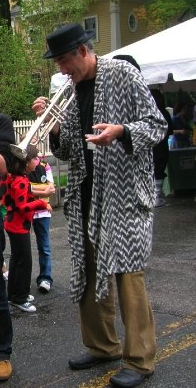
The history of jazz is complicated and resists a simple through-line narrative. It arose as a beautifully haphazard cross-pollination between musicians stable or itinerant, schooled or unschooled, making their work easier by creating songs and shouts, picking up tunes from brass and circus bands, listening in speakeasies and dance halls... All of this happening at dozens, probably hundreds of places across the U.S.
.jpeg) Those would try to shape jazz into easy stories ("born in New Orleans and travelled up the river to Chicago" sound familiar?) need to keep in mind what Quantum Physics teaches us about measurement: nothing is static and the fact that you're measuring something changes its behavior. So, the observer can measure either its position or its movement, not both.
Those would try to shape jazz into easy stories ("born in New Orleans and travelled up the river to Chicago" sound familiar?) need to keep in mind what Quantum Physics teaches us about measurement: nothing is static and the fact that you're measuring something changes its behavior. So, the observer can measure either its position or its movement, not both.
The commonest way to observe (i.e. freeze) the jazz story is through what I call the Jazz Hero approach; in other words, canonization. To make any canon viable takes historical buttressing, in the form of "experts" who produce books, collections of recordings, films, radio and television shows purporting to be historically "definitive." The two most powerful recent examples were the Smithsonian Anthology of Jazz and the Ken Burns documentary.
Jazz dissidents, who know that the Hero's shadow tends to suppress the work of other fine musicians and to over-simplify the process of creation, are always ready to undertake a critique of the canonization process. I've devoted a certain amount of space here and on my radio show The Duplex Mystery Hour to highlighting the work of musicians I think worthy of more attention: Miff Mole, Jabbo Smith, Charlie Shavers, Howard McGhee/Fats Navarro, The Roane Brothers, Joe Gordon and others. This a mixed race group, but much of the energy of the recent de-construction of the canon has gone into looking into the contribution of white musicians. I see it often on jazz Facebook groups and the leading example is Richard Sudhalter's book "Lost Chords, White Musicians and Their Contribution to Jazz 1915-1945."
Is it a good idea to write jazz history by focusing on a particular race, gender, religion or other sub-group? Does it accomplish the kind of democratization that "new" history goes after, trying to
uncover stories that are not restricted to important business and political figures or other historical "winners"?
Yes and no.
I find Sudhalter's book rich and fascinating and it has led me to investigate a number of musicians in whose work I never invested much attention. It approaches the music with new, highly-trained ears and is a great repository of biographical details and new transcriptions. So, taken on its own terms, it exceeds expectations.
However, if the goal of re-examining this music is to try and more deeply probe its complicated fabric, then using race as the means of deciding who to focus on makes the book feel, well, oddly segregated.
There are individuals both black and white not in the canon whose work should reasonably be set side by side for musical comparison. Also, the reason why a particular musician has been relegated to the back benches of jazz deserves a more sophisticated analytical lens than just race.
An historian may, for example, assign people to "white" and "black" schools of clarinet playing in order to show first of all, that there were such schools and to show that the white school was undervalued historically. But, this arbitrarily truncates the analysis and seems more like ax-grinding about the maltreatment of a group than an interesting premise for musical re-examination. In fact, players were as subject to geographical influence as they were to racial influence. The individual trumps the group. If you can recognize the playing of Leon Rappolo, Johnny Dodds, Buster Bailey or Frank Teschemacher, it's because they sound different.
.jpeg) |
| Dodds |
.jpeg) |
| Rapollo |



.jpeg)



.jpeg)

.jpeg)


.jpeg)